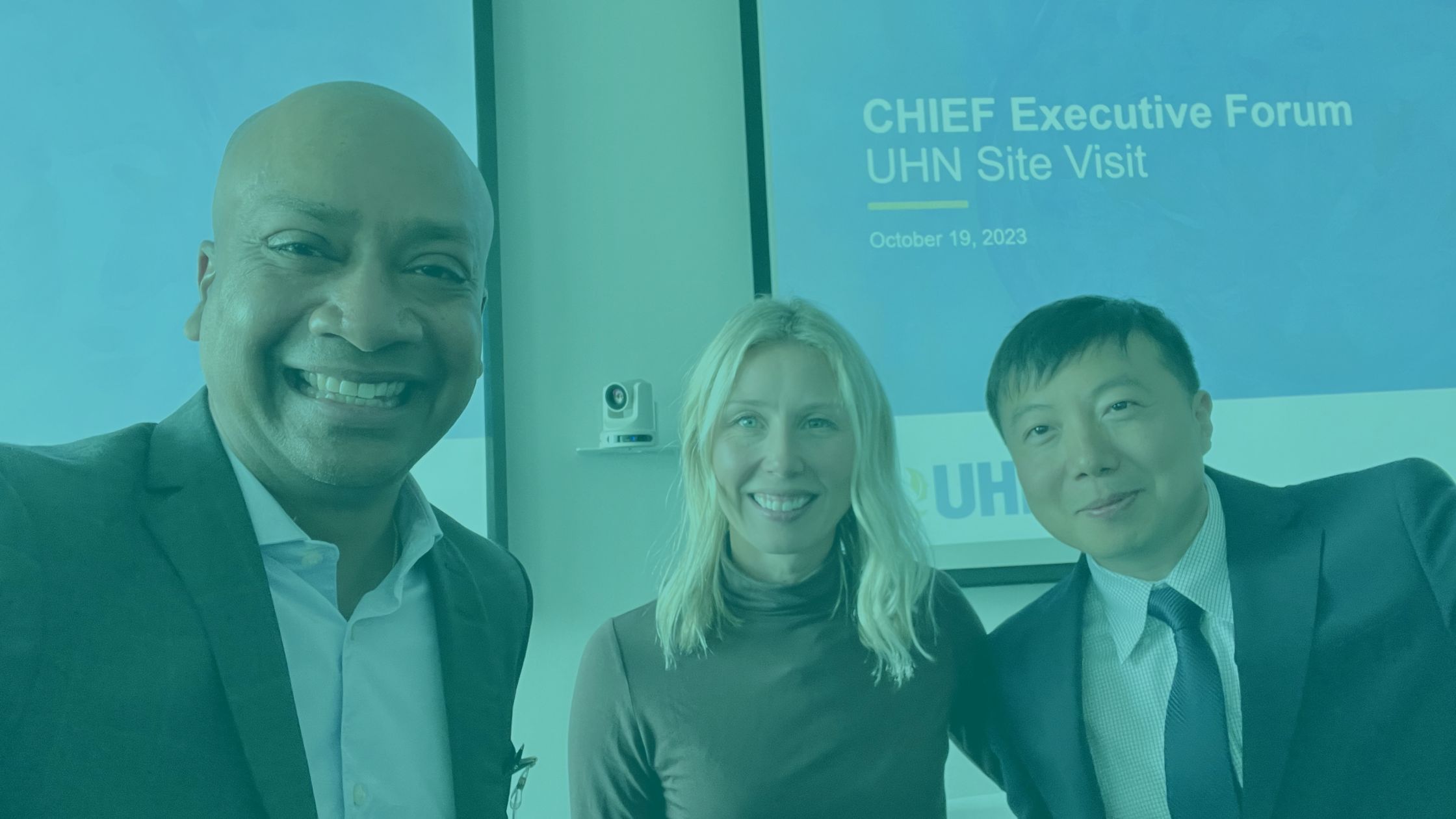
On Thursday, October 19, after a successful day of knowledge-sharing, learning, and networking at the CHIEF Executive Forum Fall Symposium, a group of 25 CHIEF members embarked on the first-ever site visits and tours to two healthcare delivery member organizations to see and hear about the AI initiatives taking place there.
The morning was spent at Unity Health Toronto (the Unity Health healthcare network is comprised of St. Joseph’s Health Centre, St. Michael’s Hospital, and Providence Healthcare). At Unity, CHIEF members were welcomed by Muhammad Mamdani, Vice President – Data Science and Advanced Analytics Toronto who gave a comprehensive overview of Unity Health’s Data Science & Advanced Analytics Program. Members of the Data Science & Advanced Analytics team were invited up to present examples of AI currently in use at the hospital, ranging from patient monitoring to nurse assignments and optimizing operations centre activities. A robust and wide-ranging conversation around innovation and private sector collaboration concluded the Unity Health morning session.
The group then made their way to the Ajmera Transplant Centre (Canada’s largest transplant program, performing over 600 transplants every year and providing follow-up care to over 7,000 transplant recipients across Canada) at University Health Network (UHN). University Health Network is a healthcare and medical research organization in that includes Toronto General, Toronto Western, and Princess Margaret Hospitals, and Toronto Rehabilitation Institute (Toronto Rehab) the Michener Institute of Education. The scope of research and complexity of cases at UHN has made it a national and international source for discovery, education and patient care.
At UHN, the group was welcomed by Shiran Isaackzs, Vice President – Altum Health & Connected Care, Shiran, who has also served as president of the Digital Health Canada Board of Directors, gave the guests an overview of UHN Connected Care and the AI Hub and introduced Bo Wang, Canada’s first hospital Chief Artificial Intelligence (AI) Scientist. Bo and his team gave a demo of Clinical Camel, an open-source AI scribe that automates clinical note generation from patient-doctor conversations.
“We’re sharing Clinical Camel-70B to promote transparency and collaborative research, paving the way for safe LLM [Large Language Model] integration in healthcare. We’re democratizing AI in healthcare. Challenges remain, including safety, outdated knowledge, and biases. But Clinical Camel bridges the gap between proprietary and open medical LLMs. Download Clinical Camel at: https://huggingface.co/wanglab/ClinicalCamel-70B – Source: @BoWang87, X (Twitter)
After the Clinical Camel demonstration, the visitors separated into two groups to see AI demos in use in other parts of the UHN campus, including a demonstration of AI used to indicate “no-go” areas in gallbladder surgery and an AI ex vivo lung perfusion.
Using AI to guide surgeons during gallbladder surgery is the brainchild of Dr. Admin Madani, a general surgeon with the UHN Sprott Department of Surgery, Dr. Madani was researching surgical techniques when data scientists suggested he could use AI to mimic the decision-making of leading surgeons. The resulting collaboration produced a prototype that uses computer vision—a field of AI that trains computers to interpret and understand images—to identify in real time areas of an organ that are safe to dissect, and those where it is dangerous to do so (source: cbc.ca).
The ex-vivo lung perfusion (EVLP) medical technique, invented at UHN, enables a donated lung to be preserved outside of the body so that it can be assessed and treated prior to transplant. This process helps to ensure that the lung is healthy and functioning properly before being transplanted into a patient.
The Ex Vivo System’s dome is connected to a circuit, which consists of tubes, a pump, a ventilator and a filter, through which the liquids, oxygen and nutrients flow. The lungs are then warmed over about 30 minutes, at which point ventilation starts, causing the organ to breathe in and out, like it would inside a body, right there in the Ex Vivo System dome.
Over the next several hours, doctors essentially operate on the donor organ to try to make it healthy again. They might remove water from the lungs, treat them with high doses of antibiotics, take out blood clots and more. Every hour, the surgeon gets updated on how the lungs are doing, and usually about three hours into this process, they will know whether the lungs are usable.
While lungs can now live on the Ex Vivo System for up to 24 hours, they are usually kept it in there for about five. Once the process is over, surgeons transplant the donor lungs into the patient, who would have already been waiting in the hospital – Source: UHN Foundation Stories
At Toronto General, surgeons currently perform double the number of lung transplants they used to, as so many organs that would have been previously deemed unsuitable can now be used. Thousands more people are living healthy and productive lives because of this device.
Visit CHIEF Membership to learn more about the CHIEF Executive Forum. and their initiatives.

